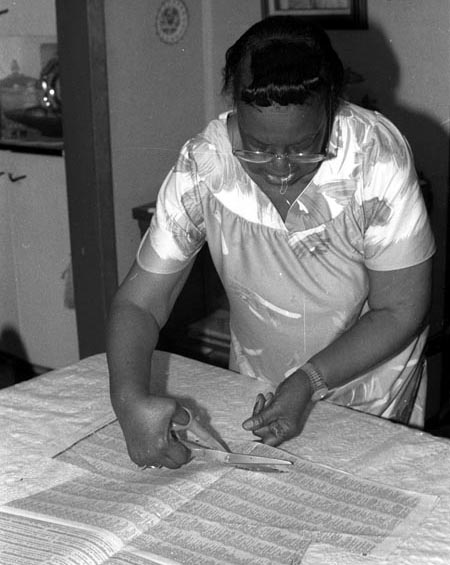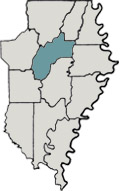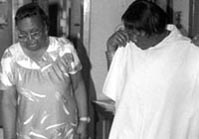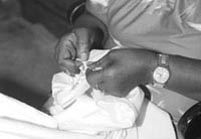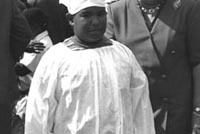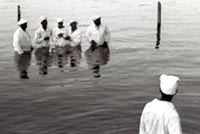Introduction to Delta Pieces: Northeast Louisiana Folklife
Map: Cultural Micro-Regions of the Delta, Northeast Louisiana

The Louisiana Delta: Land of Rivers








Ethnic Groups










Working in the Delta








Homemaking in the Delta




Worshiping in the Delta



Making Music in the Delta




Playing in the Delta







Telling Stories in the Delta



Delta Archival Materials
Bibliography

Lucille Stewart: Making Baptismal Gowns
By Susan Roach
To join the church, Baptist doctrine requires the ordinance of baptism, a ritual that traditionally calls for initiates to wear a special white baptismal gown and be immersed in water. Before the days when baptisteries in churches became common, this ritual was performed outdoors in a church pool, or more likely in nearby rivers, lakes, and bayous. Although outdoor baptisms still occur in the Delta today, most baptisms take place inside the church; however, candidates usually still wear the white robes over their clothing. While the robes may be purchased today, even online, in the past they were handmade by community members. Lucille Stewart, a native of Rayville, made her first baptismal gown for her own baptism because "I didn't know if I had anybody else to make it or not. I could, I could sew one."1 Her mother got her some fabric and she proceeded to make her own gown, as well as gowns for her brothers, and would go on to make gowns for her daughters' baptisms.
Learning to Sew
Making her own baptismal gown was not her first sewing attempt; it followed other sewing experiences. Although Stewart's mother did not do much sewing, Stewart also had watched her older sisters cutting patterns and sewing and had become interested in the skill herself, but she was too young then to do much. As she grew older, she began to watch her neighbor, Maggie, who sewed for Stewart's mother. She spent many hours watching Maggie make dresses for her family. She remembers claiming the family treadle sewing machine for herself: "Eventually, she [Maggie] wanted to keep the machine and sew because she did all the sewing. And I told my mother, I didn't want her to keep my machine; I'd sew myself." Like many young girls learning to sew, she practiced her sewing making doll clothes:
Oh! I, I tell you where I learned to sew. I had a doll. And I'd cut out things and make [them for] my doll. Finally, I decided to make things for myself. And my mother took in washing and ironing, and I remembered once a lady [one of her customers] had a dress that I wanted one like, and I got me some paper, cut that dress out, got me some material, and made it. That's the way I learned to sew. Like I cut this [baptismal gown] out. I see something that I want, I just get a pattern-some paper and cut it out. I didn't learn to sew by a pattern.
In fact, she became so adept at making patterns that she could copy a complicated dress. She tells a story about a woman bringing in a dress, along with other laundry for her mother to wash: "She had this dress and, and we was washing. I said, "Oh, this is a pretty dress. . . . I can't hardly remember how that dress was made, but I went to town, got me some material before she [her mother] washed and ironed it and got me to carry it back. I . . . cut out that pattern and made it." In those days, getting the newspapers to make the patterns was not simple since there were few newspaper subscriptions in the African American community. She reports, "My sister was working [at a plantation] and she would save me some papers. . . . The most that we had was a magazine." Given the size of magazines, they are not large enough to make a pattern without gluing pages together.
Sewing for Family and Friends
Stewart learned to make many complexly structured features such as round collars and also learned to handle thin difficult fabrics—a skill that was envied by her friends:
I could cut them. And sometime I'd have to cut maybe two or three pieces of paper before I get it like I want it. But those big round collars—I could make them. And [we] used to wear dresses with ruffles from the tail down. I remember I got me a blue—there's some blue material they used to call voile material. . . . I made me one of them. And oh some of my friend girls wanted that dress.
She had gotten the money for the blue fabric from her mother who "took in washing and ironing." She recalls how she saved this money so she could buy something different at a special store instead of the plantation store where choices were limited:
My mother gave me some money for Christmas. And I put that money in an envelope and saved for Easter and got me a dress. And I remember once, I wanted me some shoes, and we got through hoeing [crops in the fields]-we hoed out by the day, and I hoed out all week, kept that money and went to town and bought me some shoes 'cause we had a certain place we had to go buy this stuff, but if I had my own money I could go where I wanted. So that's what I did, went where I wanted, got me some shoes, and [fabric for a] dress so I didn't have a dress like all the rest of them. . . . I didn't make a white dress. It was light blue. . . . Well, pink was my favorite color, but I saw this blue. And I got me a dress in that. It was made kind of tight in the waist, and the skirt was full with them ruffles around it. That's what I made me.
Because she impressed her friends with her creations, she began to sew for her friends at that point, although she never charged them for her work. They would bring her the fabric, and they would go in the back room where the treadle machine was located and get to work. In addition, she sewed for her mother, making "dresses and little two piece suits—coat and skirt—whatever she wanted made."
As she became more experienced, she also sewed for her sisters' children and began to make quilts, as she elaborates: "But after I'd married, . . . . that's when I started quilting. But when I was coming up, I didn't fool with quilts 'cause I was interested in dresses. . . . I never pieced a fancy quilt. I just get them and put together sometime. Sometime I cut them out and I sit up night at the machine and sew them together. But I never made a fancy quilt." The quilts she made for cover for her family could be termed "everyday" quilts.
Making Baptismal Gowns
While Lucille Stewart made her first baptismal gown for herself, she continued the tradition for others in her family. She made the robes for all ages from children to adults, but most common are the children's sizes. She comments on the age of children who are baptized: "Oh, they get baptized early. Some children join church early, some doesn't. But, [the] earlier they join is better 'cause they don't have to deal with worries of life. I'll see them get baptized from eight, nine years old. And that mean[s] they grow up in church." In her own case, she was fourteen when she joined, but "had been working in church all the time." She made the robes for members of her family since her mother did not sew: "I made mine, I made my brothers, and I've been thinking . . . maybe I made my daddy's when he got baptized, seem like I made his." She recalls making robes for her own children who joined early in their lives, "no later than nine or ten years old," because their father was a pastor. She notes that the robes were not passed along after the baptism: "cause after you're baptized, you didn't have no more need for them. . . . I think we took them and sleep in them at night."
The process of making the baptismal gown is probably one of her easier sewing tasks; as she puts it, "I just cut the pattern, and I seed them made, and I just got some newspaper and cut them out." The gowns are designed with long sleeves and with the robe's skirt long enough to reach the ankles. She begins by calculating the size of the needed gown and then cutting a pattern for the gown from newspaper. She recalls that she used to measure with a piece of string and tie a knot at the correct length because she did not have a tape measure: "I had to tie that string around them waist, and I know how deep to make it. And I measured from the sleeve from the shoulder down the length that they wanted. And I'd go ahead and make it." After getting the approximate measurements, she folds the newspaper down the middle in order to cut both sides of the gown the same. When she opens up the cut pattern, the sides will match.
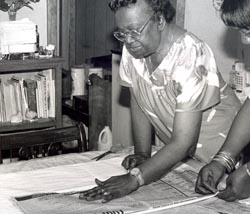
Since the only stitched seams will be on each side, she folds the fabric to have two layers of the fabric so she can cut the two sides. She then carefully places the paper pattern on these two layers. She starts by cutting the neck. As she cuts the pattern, she tries to cut a scoop neck that will give the candidate room to pull the robe over the head. To give more head room, she cuts a slit in the back piece so that the robe will slip easily over the head. The neckline will be bound with a neck band with a tie. If the robe is for a larger or taller person, she cuts the pattern sleeves longer so that they reach the wrist. If the fabric is too narrow for a very long sleeve, she will add a band of extra fabric to the sleeve. She can determine the final length of the gown after it is cut out.
After the fabric is cut out, she is ready to assemble the gown. First, she runs a gathering stitch around the neck on the seam line and then pulls the thread in order to distribute the gathered fabric pleasingly around the neckline; actually, Stewart says that it is better to put more gathers on the side to accommodate the shoulders. A facing cut from the same fabric is applied to the neckline to finish it, and ties that are five-six inches long are added to the back to close the neck in the back. Then the side seams are stitched, and the sleeves and bottom edge hemmed according to the lengths needed.
Also, Stewart traditionally made two belts to wear with the robe; these would be cut from the remaining fabric. Stewart explains their function: "One go around your waist, and one go around down there [pointing below the knees], because when you get in the water, that water would have your gown up [over the head]. But you have ties, so it wouldn't come up." She notes, "Most of the time, no string [is used]. Sometime the bottom string gets lost in the water." These belts function to keep the robe in place, thus preserving the modesty of the initiate and preventing one from becoming tangled in the skirt in the water.
Stewart also makes a band from the same fabric to wear around the head. The band does not completely cover the head in the manner of the stylized baker's hats used in the Lake Providence baptisms. She explains that they had to protect their hair from the water: "Before you go in there [the water], most times we put our—we call them 'stocking caps' on our head. Pressed our hair and had our hair fixed, but you had to put something on there [to] keep the water from getting it wet." She recounts how to make the headband: "When you make it, sew it, you sew it all the way up and then you turn it outside, and then you put a [safety] pin in it" to hold it at just the right size.
While today, churches generally furnish the baptismal robe, in her day, parents of the initiates, which Stewart calls "candidates," had the responsibility of furnishing the robe. If a family could not provide the traditionally used robe, Stewart suggests an alternative, "Well, that this was a tradition that you baptize in a robe, but if you didn't have them, [you] put on some dress . . . and went on through the water." Her statement indicates the ultimate importance of carrying out the Baptist church ordinance of baptism.
Epilogue
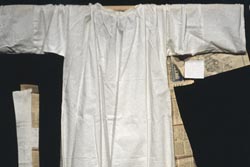
Married to minister Reverend James Stewart for 56 years, Lucille Stewart continued to be a devout member of her church, the Pine Hill Baptist Church in Rayville, until her death at the age of 93 on April 4, 2006. Undoubtedly, her belief in the sacrament of baptism contributed to her experience in making the baptismal gowns. Aesthetically, she loves the white robe, commenting, "It's a pretty sight—all dressed in white. . . . [and the] pastor be out in the water in white." When asked why white was used, she replied, "Well, that was the tradition—white. It's like when they have the sacrament [communion of the Lord's Supper], the mothers [of the church] are supposed to be in white." To her white represents the "purity" which the candidate attains when baptism symbolically washes away sin and initiates the candidate into the church. The robe Mrs. Stewart started during that interview was made for the Creole State Exhibit. Today it is on exhibition in the Louisiana State Museum in Baton Rouge as a testimony to her belief and creativity.
Note
1. I must thank Annie Staten for her part in our interview with her mother at her home in Rayville, Louisiana, on June 17, 1994. She arranged the interview and was able to draw out many of the family stories about her mother's family and sewing experiences. All quotations in this essay are from this interview.



